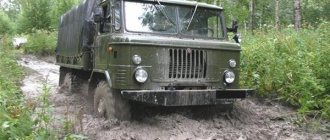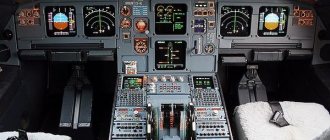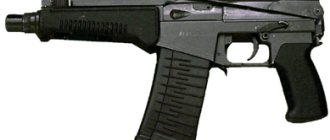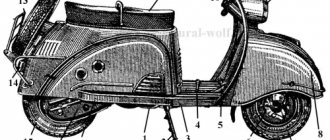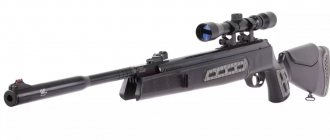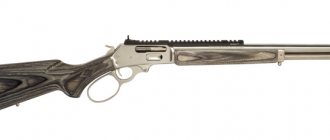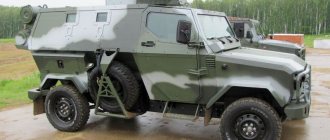At all times, special attention was paid to the equipment of the military, especially if the assigned combat missions were carried out under water. The universal diving knife (NVU) is intended for divers-sappers who eliminated underwater mines. Such a tool must be as reliable as possible, given that the underwater world is too dangerous, especially in wartime. Underwater, in addition to enemy mines, various threats can be hidden: from fishing nets to enemy submariners. So, the weapon with which it is immersed under water should easily cope with all the dangers.
Heavy diver's knife.
History of creation
In the 60-70s of the twentieth century, more practical hose scuba tanks of the ShAP-40, ShAP-62 and ShAP-77 types were created to perform tasks at shallow and medium depths. Their use significantly reduced the overall weight of the diver's equipment, due to which oxygen cylinders for emergency situations were included in the basic package, which made it possible to breathe in extreme conditions or in cases where the hose is disconnected while performing a task in a confined space.
By improving equipment, divers were able to perform a wider range of tasks and at the same time reduce the level of danger when performing them.
Considering that the ventilation system had changed, it became necessary to change the sea knife with which all divers were equipped. At the end of 1970, a new model called NVU (universal diving knife) entered service. Since that time, this weapon began to be included in the basic equipment of submariners of the USSR Navy, as well as underwater special forces. It was used to overcome small underwater obstacles, such as abandoned fishing nets and cables, that is, it cuts through all obstacles that interfere with the work.
Special diving knife.
In addition, with the help of a knife you can eliminate underwater predators, and in wartime, enemy swimmers.
Knife Marine, forged steel X12MF, HP K-43 ar
Blade: corrosion-resistant steel X12MF, razor bevels, engraving, hardness 59-60 HRC
Handle: hand carved, Ebony, cupronickel.
Sheath: genuine leather
Knife dimensions in mm:
Overall/blade length: 268/150 Maximum blade thickness/width: 3.6/22
Handle section in the center: 20x26
8,000 rub.
Add to cart
You can buy a copy, a replica of the HP reconnaissance combat knife, HP-40 in various designs here.
You can buy the HP-40 Scout Knife in collectible and gift versions, with a Damascus steel blade and a carved Black Rosewood handle here:
Scout knife HP-40 collectible
Contents: knife, sheath, certificate.
You can buy a Scout knife at manufacturer's price in our online knife store.
Delivery by mail, courier or pickup in Moscow.
The Scout knife is available for sale in various blade and handle materials.
History of the HP-40 Scout Knife.
Scout knife model 1940 NR-40 (Army knife NA-40) is a combat knife that was in service in the Red Army and the Soviet Army and the armed forces of some Warsaw Pact countries from 1940 to the 1960s.
In the early to mid-1930s, legislation regarding the circulation of bladed weapons was tightened in the RSFSR.
The Criminal Code now includes a direct ban on the manufacture, storage, sale and carrying of Finnish knives. At this time, NKVD employees have been receiving a Finnish knife as a special tool since 1935 (in some documents “Norwegian-type knife” or “Swedish-type knife”), several versions of which are manufactured (former factory of industrialist Kondratov) in the village of Vacha, Nizhny Novgorod region. The NKVD knife is based on a Swedish knife produced by P. Holmberg, which was banned as a “Finnish knife.” The knife was characterized by either a straight spine or a spine with a characteristic bevel, a “pike”, fullers and a Finnish type of handle head. Unlike the traditional Finnish knife "puuko" there was a developed curved guard, usually S-shaped. In front of the guard, an unsharpened heel was left on the blade for transferring the index finger to the blade in some grips. The handle was made of wood or carbolite. The knife was not officially in service, but was issued as clothing allowance. From the 1930s to the end of the 1970s, he completed at least 6 large orders for similar knives.
In 1940, after the Finnish War, there were new types of authorized edged weapons, in particular, a new army knife was adopted.
The alleged prototypes of the Soviet army knife include:
· Finnish uniform brazz bayonet-knife from 1919, designed by the artist Akseli Gallen-Kallela and produced by Fiskars, this model combined a blade with a lower spine line, fullers and a developed heel, an S-shaped guard, a saber handle with a metal back, an all-metal sheath, repeating the curve of the sheath of the Finnish puukko knife, and the lanyard brush, borrowed from long-bladed weapons;
· Finnish scout knives (partiopuukko) - knives designed for boy scout organizations in different countries, with clear signs of American traditions: a double-sided (less often one-sided) guard stop, a blade with a predominantly beveled spine, a narrow or wide fuller. Scout models, purchased with personal funds, enjoyed some popularity among soldiers of the regular Finnish army
| Characteristics of a 1940 model army knife | |
| Total length of knife, mm | 263 |
| Blade length, mm | 152 |
| Maximum blade width, mm | 22 |
| Maximum butt thickness, mm | 2,6 |
| Blade material | Steel U7 |
| Handle material | Tree |
| Method of attaching the blade to the handle | Mounted through installation with riveting of the shank |
The blade has a beveled butt (pike, clip-point), the slopes occupy about half the width of the blade, there is a pronounced heel in front of the guard for moving the index finger onto the blade. The most characteristic feature of the scout knife is the S-shaped crosshair of the guard, which has an unconventional bend: on the side of the blade, the guard stop is bent not towards the handle, but vice versa towards the blade. This unusual “inverted” guard is due solely to the combat orientation of the knife: the main grips were considered to be straight inverted with the blade directed upward (for bottom-up strikes to the abdomen and hypochondrium), or reverse (for top-down strikes to the neck area). In both grips, the knife lies in the hand “upside down” relative to the usual traditional position of the knife, therefore the guard received a corresponding bend. The handle and scabbard were made of wood and painted black (to avoid unmasking during night operations), but the blade was not blued or coated. It was recommended to carry the knife on the waist belt on the left side at an angle of 30°, with the handle to the right.
Features of the NVU universal knife
The submariner's knife has a blade length of 16.4 cm. It is more reminiscent of a spear, which significantly improves the penetrating ability of the weapon; also for this purpose, the butt was sharpened in front, the rest of it has a serrated sharpening, which allows you to quickly saw through a cable or net.
The Soviet NVU knife is buoyant, meaning it sinks. But its design is such that when it reaches the bottom it becomes vertical, with the handle facing upward . Due to this amazing ability, the knife is very easy to find under water.
The main material of the weapon was steel, which was resistant to corrosion. To protect the hand from cuts during hard work, the blade is separated from the handle by a small cross. The handle is made of plastic, mounted using a mounted type. There are ridges on the handle to prevent the knife from slipping. The pommel is made of steel, which allows it to be used as a hammer.
The sheath is made of plastic and can be attached to the forearm or shin. The weapon itself in the scabbard is secured with a rubber pad, which allows you to instantly remove the weapon and also minimizes the risk of loss.
Components
The universal model of a knife for divers from the times of the USSR consists of the following parts:
- Stainless steel was used to produce the blade;
- brass bolster;
- Heavy-duty plastic was used to make the handle;
- a nut with which the blade was attached to the handle;
- sheath;
- belt for fixing the gun on the belt;
- spare belt;
- safety cord.
NVU utility knife.
Russian navy knives
Multi-purpose knife NVU. Photo Zonwar.ru
Various units and units of the Russian Navy are armed and supplied with a whole range of knives for various purposes. Knives of one type or another can be used by combat swimmers, ship crews or military personnel of coastal units. Depending on the tasks at hand, such products help to conduct hand-to-hand combat or perform various tasks. Let's look at the most interesting examples of naval knives.
Utility diving knife
One of the main users of various knives in the Navy are diving units.
In the past, various versions of working knives were developed specifically for them, incl. with the possibility of use as a weapon. In the late seventies, the next example of this kind was the “Universal Diving Knife” NVU. Despite the emergence of new products, the NVU still remains in service. The NVU has a total length of 320 mm with a blade length of 164 mm. The blade is made of stainless steel or non-magnetic metal (modification NVU-AM). A one-and-a-half sharpening is used, forming a pointed combat end for delivering piercing blows. Most of the butt is occupied by the serrator (absent on NVU-AM). The plastic riding handle has a spindle shape with ring protrusions for easy holding. A cross guard is provided to protect the hand. The handle has a pommel for use as a hammer.
The utility knife is equipped with a plastic sheath with a retaining rubber ring. The sheath has a two-point attachment to the diver's equipment.
The NVU product quickly became a common working tool among divers. With its help it was possible to cut or saw various materials, as well as deliver piercing or crushing blows. For the same reasons, the knife was appreciated by combat swimmers.
Diving knife from KAMPO
A further development of the concept of a multi-purpose working knife can be considered the “Diving Knife” developed by KAMPO JSC, accepted for supply several years ago. This product is intended for a variety of work and has expanded functionality. It is also possible to use NV for self-defense.
Modern NV knife. Photo KAMPO / kampo.ru
In terms of dimensions, the NV is similar to the NVU, but differs in the size and proportions of the blade. The blade made of steel 100Х13М or 95Х18 has a characteristic shortened edge with a one-and-a-half sharpening. The butt is provided with a long serrated sharpening. The side surface of the knife carries a ruler for quickly measuring objects. The blade is connected to a mounted plastic handle, made integral with the cross. As a top there is a block with a hole for a safety cable - it can be used as a hammer.
The sheath for KAMPO NV is similar to the product for NVU, but has a different shape and is made of different plastic. At the same time, the two-point suspension to the diver’s equipment and the loop holding the knife handle are preserved.
Marine utility knife
To carry out rigging and other work in the fleet, the so-called. boatswain's knives - in the past these were two-device products with a blade for cutting objects and piles for working with ropes and cables. Now a new version of such a product, the “Universal Marine Knife” from KAMPO, has been developed and is being prepared for production.
Adopted by NMU. Photo KAMPO / kampo.ru
The NMU is foldable and includes three items. Long and short blades of different configurations are attached to one side of the handle. The short blade is equipped with a stripper for cutting cables. At the top there is a folding pile for working with ropes. In terms of functions and tasks, the NMU is similar to the old boatswain's knives, but has a modern design and improved ergonomics.
A few days ago, the Ministry of Defense announced the implementation of measures to adopt NMU into service with the Navy. By the end of the year, the product will be accepted and put into series.
Composite "Moray eel"
Combat swimmers used NVU knives as a universal tool for combat and work. Subsequently, several specialized designs with characteristic features appeared. One of these products was the Murena combat knife, developed by the SARO enterprise at the request of the Navy in order to equip units of anti-sabotage forces and means (PDSS).
Knife “Moray eel” with a hacksaw blade installed. Photo Zonwar.ru
The tactical and technical specifications for the future "Moray" were particularly complex. The customer required both cutting of soft objects and sawing of hard ones. The knife had to cope with ropes, seaweed, nets and metal up to 15 mm thick with equal efficiency. Such a combination of characteristics in one blade turned out to be impossible, as a result of which an unusual design was proposed.
The Moray blade is made of steel 65Х13 and has a beveled edge with a one-and-a-half sharpening. There is a long recess in the butt. On its surface there is a serrator with a large tooth, as well as a longitudinal groove. An additional hacksaw blade is installed in the groove for cutting metal objects. The handle is made in the form of a pair of plates on the shank. The crosspiece is part of the blade strip. The knife is equipped with a plastic sheath with a textile loop that secures the handle.
According to known data, "Moray eel" reached production and was supplied to the relevant units of the Navy in limited quantities. The actual effectiveness of the main design solutions has not been reported. At the same time, the composite design of the multifunctional blade caused controversy in the circles of bladed weapon lovers.
"Needle" and its sheath
According to known data, the PDSS is also armed with the Igla combat knife developed by the Melita-K enterprise. The knife and its sheath are a complete complex designed to solve all the basic tasks of cutting or chopping various materials.
"Needle" and its sheath. Photo “Melita-K” / melitak.ru
The Needle knife itself is a 319 mm product with a 173 mm stainless steel blade; different brands are used. There is a pointed combat end with one-and-a-half sharpening. The butt is equipped with a serrator and a 10 cm ruler. Near the cross there is a recess for breaking the wire. The handle is plastic mounted with a metal pommel.
The sheath is made in the form of a plastic case with metal parts installed on it. The sheath contains a folding awl, wire cutters with relatively long handles, a combination hacksaw for wood and metal, and a screwdriver. The sheath with the tool is placed in a textile case for hanging on the equipment.
Close-up of Needle tools. Photo “Melita-K” / melitak.ru
The Igla product demonstrates an integrated approach to the design of combat knives. The main required functions are implemented within the knife itself. Other capabilities not available for a simple blade are provided by a specially designed sheath.
From past to future
The development of combat and working knives for the Navy has been going on for decades and has led to the emergence of a number of different designs.
At various times, universal and specialized models were proposed and put into service for divers and combat swimmers, as well as for ship crews and soldiers of coastal units. Some designs were used only in some circles, while others were more widely used. As a result, over the 20th century, naval knives have come a long way from the simplest designs made from old materials to complex multi-subject and multifunctional devices with a wide range of capabilities, made from modern alloys and plastics.
The latest steps in this direction can be seen right now in the latest news. It can be assumed that even more advanced designs will appear in the future. Thanks to this, the fleet will not be left without knives - the most important tools that remain invisible against the background of ships.
